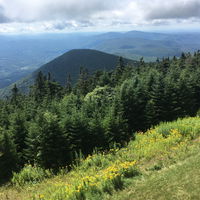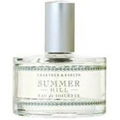10/03/2025

Trillium
4 Reviews

Trillium
1
An ambergris bath of sweet spices and a modern reinterpretation
I have a vintage bottle of the original Nantucket Briar. Unfortunately through the aging process it has morphed into something too sweet and cloying to wear, but if I spray just on paper, for the first few minutes I can smell some of the original notes.
The dominant base note was ambergris - sandy, woody, somber, and salty. There’s something pleasing and dry about it that I recognize from trips to historic tourist sites like Mackinac, Boston, Roscoe Village, etc and for some reason I associate it with canons being fired, but it’s not a sulfurous gunpowder note. Perhaps it’s the smell of old wood that has absorbed fireplace smoke and tobacco over the centuries.
The floral note was originally a soft, solo wild rose type - maybe eglantine as that was in C&E’s repertoire at the time.
The spices included clove, cinnamon, and another one (allspice? dried citrus? rose hips?) that gave it a distinctive old-fashioned potpourri quality. The overall powdery quality wasn’t sweet and seemed to come solely from ambergris, resembling powdery white sand.
*
The “modern” Nantucket Briar opens as an airy, cool and sweet perfume-like powder with clove and cinnamon and a touch of bergamot. After a few minutes a very strong pink bubblegum note elbows its way to the forefront, with a vanilla hint. I can only guess this is the floral hydrangea accord mingling with cinnamon and clove, because I can’t sense the other florals listed.
Note: hydrangea was not a note in the original formulation; its sole floral accord was meant to represent the Rosa rugosa (“beach rose”) woody brambles and pink blossoms that have invasively framed the beaches on Nantucket and Cape Cod for hundreds of years. Hydrangea was perhaps selected to help customers further identify the fragrance as describing modern Nantucket.
After about half an hour the sweetly strong middle note settles down to soft, skin-level ambery powder with faint spices. Depending on the state of my fluctuating body chemistry a rather sour, muddy patchouli note might come out. I do have to be careful about choosing when to wear this in order to avoid that.
I also have the body spray, which consists only of the pleasant base notes and a soft patchouli that behaves better.
*
Nantucket’s historic industry was whaling - the exact species that ambergris derives from. Crabtree & Evelyn’s founder was from New England and his intent to create a fragrance authentic to Nantucket cannot be overstated.
From online discussion and rumor of “an ingredient that ran out” in the 90s, the loss of ambergris was probably the reason for a complete reformulation by the 2000s (also a change of ownership). I’ve read that the first reformulation was unrecognizable by customers, so the company attempted a 2nd reformulation which resulted in the current form, but used patchouli as a substitute for ambergris. I think I would have preferred a more woody (briar or basket-weave) note instead.
My family visited Nantucket in the early 80s when I was about 5 years old. We were without a car because my parents didn’t realize that a car reservation was required for the ferry and not to be booked at the last minute. We were staying in a lonely house surrounded by untouched country land and bog in the middle of the island, so someone in the town offered to loan us their station wagon. It was a very different time in the island’s evolution (also early in the season, cool, rainy and quiet).
This was the connection I had with the fragrance’s name a few years later, which I bought as scented drawer liners and a vacuum powder to be sprinkled on rugs and carpet that physically resembled sand. The sandy, clean and faintly spicy aroma filled my teenage bedroom for years, and has biased me to own the reformulation no matter what the quality. I am constantly looking for another perfume more closely resembling the original (which might not even be possible).
The dominant base note was ambergris - sandy, woody, somber, and salty. There’s something pleasing and dry about it that I recognize from trips to historic tourist sites like Mackinac, Boston, Roscoe Village, etc and for some reason I associate it with canons being fired, but it’s not a sulfurous gunpowder note. Perhaps it’s the smell of old wood that has absorbed fireplace smoke and tobacco over the centuries.
The floral note was originally a soft, solo wild rose type - maybe eglantine as that was in C&E’s repertoire at the time.
The spices included clove, cinnamon, and another one (allspice? dried citrus? rose hips?) that gave it a distinctive old-fashioned potpourri quality. The overall powdery quality wasn’t sweet and seemed to come solely from ambergris, resembling powdery white sand.
*
The “modern” Nantucket Briar opens as an airy, cool and sweet perfume-like powder with clove and cinnamon and a touch of bergamot. After a few minutes a very strong pink bubblegum note elbows its way to the forefront, with a vanilla hint. I can only guess this is the floral hydrangea accord mingling with cinnamon and clove, because I can’t sense the other florals listed.
Note: hydrangea was not a note in the original formulation; its sole floral accord was meant to represent the Rosa rugosa (“beach rose”) woody brambles and pink blossoms that have invasively framed the beaches on Nantucket and Cape Cod for hundreds of years. Hydrangea was perhaps selected to help customers further identify the fragrance as describing modern Nantucket.
After about half an hour the sweetly strong middle note settles down to soft, skin-level ambery powder with faint spices. Depending on the state of my fluctuating body chemistry a rather sour, muddy patchouli note might come out. I do have to be careful about choosing when to wear this in order to avoid that.
I also have the body spray, which consists only of the pleasant base notes and a soft patchouli that behaves better.
*
Nantucket’s historic industry was whaling - the exact species that ambergris derives from. Crabtree & Evelyn’s founder was from New England and his intent to create a fragrance authentic to Nantucket cannot be overstated.
From online discussion and rumor of “an ingredient that ran out” in the 90s, the loss of ambergris was probably the reason for a complete reformulation by the 2000s (also a change of ownership). I’ve read that the first reformulation was unrecognizable by customers, so the company attempted a 2nd reformulation which resulted in the current form, but used patchouli as a substitute for ambergris. I think I would have preferred a more woody (briar or basket-weave) note instead.
My family visited Nantucket in the early 80s when I was about 5 years old. We were without a car because my parents didn’t realize that a car reservation was required for the ferry and not to be booked at the last minute. We were staying in a lonely house surrounded by untouched country land and bog in the middle of the island, so someone in the town offered to loan us their station wagon. It was a very different time in the island’s evolution (also early in the season, cool, rainy and quiet).
This was the connection I had with the fragrance’s name a few years later, which I bought as scented drawer liners and a vacuum powder to be sprinkled on rugs and carpet that physically resembled sand. The sandy, clean and faintly spicy aroma filled my teenage bedroom for years, and has biased me to own the reformulation no matter what the quality. I am constantly looking for another perfume more closely resembling the original (which might not even be possible).




 Top Notes
Top Notes  Bergamot
Bergamot Carnation
Carnation Citrus notes
Citrus notes Heart Notes
Heart Notes  Eglantine rose
Eglantine rose Hydrangea
Hydrangea Jasmine
Jasmine Peony
Peony Base Notes
Base Notes  Amber
Amber Patchouli
Patchouli Spices
Spices Vanilla
Vanilla






















